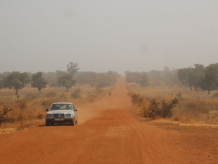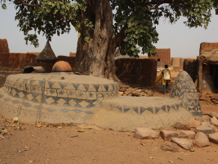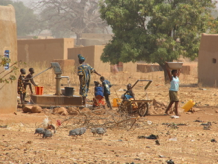From Houston to Sydney 2013

West Africa
2014
We started the day in Ouagadougou, and we finished the day in Ouagadougou, but we spent most of the day out of Ouagadougou.
Our first task this morning was to get our visa for Benin (the country we will visit after Niger) from the Beninese consulate here in Ouagadougou. This was a surprisingly painless experience. We drove to the consulate, which is in the eastern part of Ouagadougou, filled in our application forms, obtained photocopies of our passports (with mama’s help), handed in our two passport photos and the fee of each 40,000 francs each ($Aust.92), and after an hour’s wait on the shady verandah listening to a French tourist complaining that the Beninese Embassy would not issue him with a visa for Congo (yes, a different country, half a continent away), we received our passports and visas and proceeded on our way.
Our big destination today was the small village of Tiébélé, located two and a half hour’s drive south-east of Ouagadougou, about 35 kilometres east of Po, almost on Burkina Faso’s southern border with Ghana. The people in Tiébélé are of the Gourounsi tribe, which migrated to the area from Ghana but have now become fully Burkinabèised.
The reason that we travelled to Tiébélé was to see its distinctive “sukhala”, which are colourful, windowless, fortress-like houses whose exteriors are brightly coloured by the women. The women paint traditional symbolic, geometric designs on the buildings in brown, white and black colours.
When we arrived in Tiébélé, we were shown into one of the sixty-odd hamlets that comprise Tiébélé. It was a royal compound, which meant that there was a king living in one of the huts (that was up at the eastern end, near a banana tree). The people living in the compound were a mix of animists, Christians and Muslims, and the presence of the animists was evident as we saw several small shrines covered in feathers where chickens had been sacrificed.
We were very fortunate that a group of women was working on one of the walls – they usually paint once every three days because of the time needed for one coat to dry before the next is applied.
The traditional style of the “sukhalas” is like a figure “8”, i.e. two intersecting circles when seen from above. We were invited into one of these houses, having to crawl through the low doorway into the dark interior. The first room entered is the living area where people sleep at night. Crossing into the second room, the kitchen, involved crouching down low again while simultaneously straddling a raised lip of about 80 cm – a task that required more than a little flexibility and dexterity. Once in the kitchen we were able to see the stove, grinding stones, and pots that are stored in a hanging macramé basket.
For the final part of our visit to Tiébélé, we were invited on to the roof of one of the houses for an overall view of the compound. The roofs are flat as they are used for sleeping in hot weather, and for storing peanuts and grains. The panoramic view at the end of today’s diary shows the view from the roof.
The sad thing about Tiébélé is that this distinctive architecture might be lost within a generation or two. Young people are expressing a preference for square houses made of concrete blocks rather than the traditional mid brick structures, and it is possible that the traditional compounds may be completely abandoned within a few decades.
Our visit to Tiébélé lasted for an hour (12:30 to 1:30 pm), after which we undertook the two and a half hour return drive to Ouagadougou. Part of the drive was through the Kaboré Tambi National Park. Apparently it is possible to see elephants crossing the road in this area. We did see many guards in camouflage outfits carrying machine guards to guard against illegal poachers who hunt elephants for their ivory, but alas we saw no elephants.
After returning to Ouagadougou at 4:00 pm, we made just two quick visits as the sun was already getting low on the smoky horizon. The first stop was one that I requested, La Place de la Revolution. Featuring a socialist style mosaic and flame-topped tower made of concrete, this vast paved square is closed to the general public because it has been the site of anti-government protests – somewhat surprising given that it is surrounded by various army bases.
Our final stop of the day was the Grand Marché (Big Market). After the Grand Marché in Bobo-Dioulasso, the Ouagadougou Market was somewhat disappointing. Apparently the market burns down periodically, and the current (new) building accommodating the market is an uninspired design made of very flame-resistant concrete. We arrived at about 5:00 pm, and it was clear that we were at the end of the trading day, with sellers starting to pack away their wares. Of course, that didn’t discourage the very persistent stall owners from trying to sell us table cloths, batik shirts, soccer shirts, track suits, leather belts and everything else you could imagine.
As we had missed lunch today, we decided to have dinner as soon as we returned to the hotel at a little before 6 pm. To be more precise, we ordered at about 5:55 pm and received our dinners at 7:10 pm. It was worth the wait, however – the food in Burkina Faso has not disappointed us yet.

Monday
13 January 2014

Day 17 - Tiébélé, Burkina Faso






































